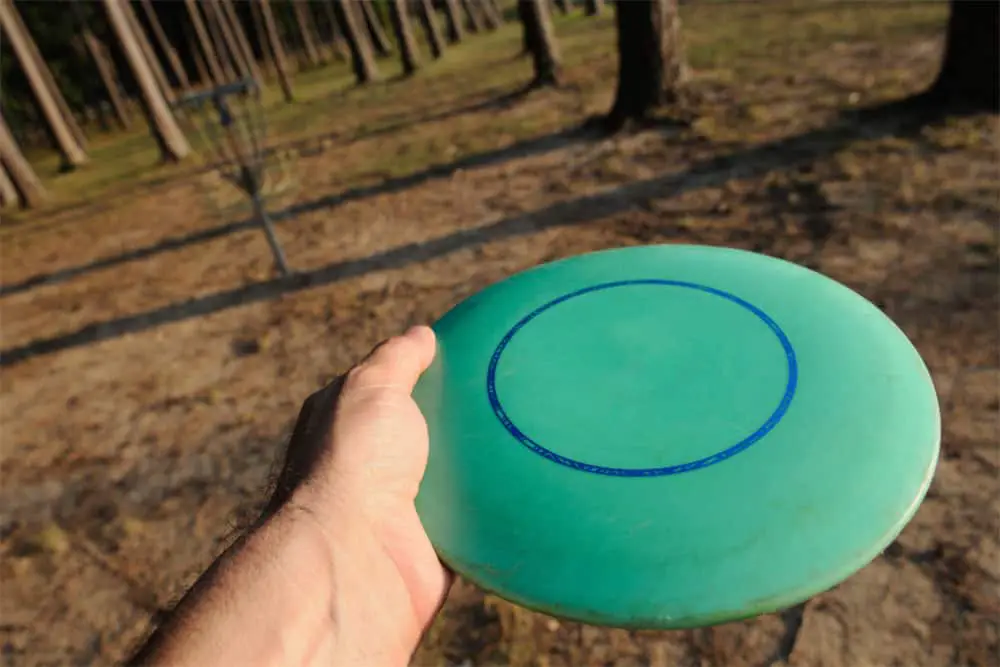While the rules of disc golf are not complex, they are often misunderstood and are often the subject of debate. But understanding the rules is useful when an uncommon situation not covered by the putting rules arises.
Putting is an important part of the game, and not understanding the rules puts you at risk of penalty shots.
Below, we’ll go over the putting rules and this should hopefully give you an understanding of how many steps you can take in disc golf. We’ll also discuss technique and how many steps are needed for effective putting.

There are two Circles in disc golf that indicate the putting area of each hole. Circle 1 is any area within 10 meters (32.8 ft) of the basket and any throw from this area is considered a putt. Meanwhile, Circle 2 is any area within 20 meters (65.6 ft) and outside of 10 meters from the basket.
However, it’s worth noting that Circle 2 is not an official PDGA designation and shots in this area do not come under putting rules. Circle 2 was merely created as an analysis tool and is rarely marked on the course. Circle 1 is usually marked for sanctioned tournaments.
If you’re unsure whether you’re in Circle 1 you can ask the members of your group. Other players in your group are responsible for pointing out your violations and any disagreement needs to be taken to a tournament official.
It’s always best to ask the people enforcing the rules clarifying questions before the game so you can avoid penalties.
Keeping these parameters in mind, you should be able to gauge how many steps you can take in disc golf. Let’s take a closer look at technique, and how that impacts how many steps you can take in the game.
There are four factors that really influence how you throw, these are your feet placement, rotation of your hips, rotation of your head, and straightening your arms and elbows. Feet placement is the most important aspect in regards to how many steps you can take.
When you’re walking up on the tee, the old adage is true – slow and steady wins the race! A few small steps will do when going through your throw motions. Always start with your foot that is the same side as your throwing arm.
For example, taking 3-4 steps before you turn your body and then taking one final big step with your chosen foot again should suffice.
Meanwhile, rotating your hips is what gives you momentum. In the middle of your throw you’ll want to get a good rotation in order to achieve maximum distance.
While you may think you need to keep your head straight in order to throw your disc, this isn’t actually true. In the middle of your rotation, your head should rotate with you and down so that your hips can get the maximum rotation. You should turn your head back just in time to see the target and launch your disc.
When your arm goes back behind your body, you need to straighten it out almost completely before you sling it forward. This gives you the most momentum out of your throw by the time the disc comes back to be thrown in front of your body.
So now we have an idea about how many steps we can take, is there alternative ways to putt without taking any steps at all?
It is, in fact, legal to putt from your knees in disc golf as long as you have one balancing point inside your lie and you’re not touching anything in front of your lie. You can even lie down in disc golf following the same guidelines.
However, you cannot putt while sitting on a disc golf stool. According to PDGA Rule 813.02, no device can be used to directly assist with making a throw, and disc golf stool is considered to be such a device as it assists your balance and stance.
Any items questioned by another player are also automatically considered illegal until approval is given by a tournament official. However, many players consider a disc golf stool a hindrance to their game rather than an asset.
Can You Step Past Your Disc In Disc Golf?
There are no rules specific to disc golf putting stances that do not apply to normal throwing, so you’re probably already familiar with the PDGA rules on throwing stances.
But the first thing you should know is that your lie starts at the back edge of where your disc landed and is 20cm wide (7.8 inches) and 30cm deep (11.8 inches). This is a fairly small area.

You can replace your disc with a mini marker touching the front edge of your disc, but you must have one body part keeping you balanced inside the lie and you cannot have any body parts balancing yourself in front of the lie.
For example, you cannot lean against a tree limb that is closer to the basket than your disc. However, it is legal to lean backward against a tree as long as you still have one foot in the lie to keep you balanced. As your lie is on the ground you cannot putt from a tree without balancing your lie on the ground.
One specific putting rule that does not apply to standard throws is the rule that, after having released a putt, the player must demonstrate full control of balance behind the marker disc before advancing toward the target.
When you are in Circle 1, you cannot step over your lie during your putting motion. This is a pretty vague rule, but the most common interpretation of this rule is that you have to visibly pause after you have released the disc before you can cross over your lie.
This is a rule worth remembering so you can explain your group or tournament official if you step over your marker quite a lot when putting.
